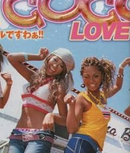B-Gyaru (Bギャル) is the name for the fusion of Gyaru with B-Kei fashion and therefore inspired by the hip-hop subculture. It is a fusion of Japanese and Western aesthetics, blending elements from both cultures. The name of the style is derived from the members of the breakdance scene, which are commonly referred to as B-Boys and B-Girls.[1]
The style features not only baggy shirts and pants commonly worn by men in the hip-hop scene but also incorporates tight clothing in a provocative manner. B-Gyaru often lean towards body-conscious fashion infused with elements typical for Gyaru in general, such as tans, big eye makeup, and deco nails. There is a tendency to show off an exaggerated wealth in the form of plenty of gold jewelry accessories.
Hairstyles play a significant role in B-Gyaru fashion and encompass a wide range of possibilities. Elaborate braids, extensions, and occasionally locs are commonly seen, paying homage to the creativity and artistry of Black hair culture. Additionally, B-Gyaru fashionistas embrace accessories such as hoop earrings, long acrylic nails, dramatic eyelashes, tattoos, diamond chains, caps, and durags to complement their looks.
B- style serves as a rebellious statement against societal norms and cultural ideals in Japan. By incorporating elements from Black culture, B-Gyaru enthusiasts challenge traditional beauty standards and assert their individuality. However, this cultural fusion has sparked controversy, particularly with Western audiences who accuse it of cultural appropriation.
In Japan, B-Kei fashion has faced its own set of challenges. B-gals and B-boys, as they are often called, have been stigmatized and associated with troublemaking due to their connection with Black culture. This negative perception stems from deeply ingrained prejudices and stereotypes prevalent in Japanese society.
During the 2010s, B-Gyaru style gained significant popularity, partially driven by the success of the clothing store Baby Shoop. The brand's bold and edgy designs resonated with B-Gyaru fashion enthusiasts, contributing to the widespread adoption of the trend. However, in recent years, B-Gyaru has experienced a decline in popularity, partly influenced by criticisms of cultural appropriation from Western netizens.
Despite the controversy surrounding B-Gyaru, many enthusiasts argue that their adoption of this fashion style is not meant to disrespect or exploit Black culture. Instead, they claim it is a way to appreciate and pay homage to the contributions of Black culture in music, beauty, and fashion. The intent behind B-Gyaru fashion is to celebrate the creativity and individuality that Black culture represents.
In conclusion, B-Gyaru is a distinctive subgenre of Gyaru fashion that integrates elements from Breakdance culture, particularly 90's hip-hop, R&B fashion, and Dancehall clubwear. It embodies a fusion of Japanese and Western styles and serves as a means of rebellion against societal norms. While facing criticism for cultural appropriation, many B-Gyaru enthusiasts maintain that their fashion choices are rooted in admiration and appreciation for Black culture's contributions to music, beauty, and fashion.
(It's manily Gyaru, but cultural appropiation plays a part in this.)



